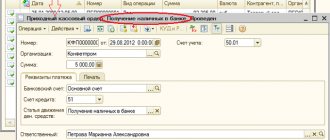Cash inventory is a procedure necessary both in preparation for the preparation of annual financial statements and in a number of other cases. Cash in the organization's cash register is specially accounted for, because money is the most liquid asset of an enterprise and is more often the object of theft than other types of property. That is why it is in the interests of the company to conduct a regular inventory of funds. Read the article on how to do this correctly.
The cash register inventory is carried out in accordance with the order of the Ministry of Finance of Russia dated June 13, 1995 No. 49 “On approval of methodological instructions...” (Methodological instructions).
Do not forget to sign agreements on full financial responsibility with materially responsible employees (MREs) who have access to funds and documents. If such an agreement is not concluded, then if a shortage is identified, the organization will not be able to withhold the full amount of damage from the employee (Articles 241–244 of the Labor Code of the Russian Federation).
Briefly about the main points of a sudden check of funds stored in the cash register
Inventory can be carried out for several reasons:
- identifying excess or shortage of cash in the cash register;
- end of the calendar year;
- change of financially responsible person;
- liquidation of the enterprise;
- force majeure circumstances (fires, floods, etc.).
The inspection must be carried out by a commission consisting of several employees, as well as in the presence of a person who is responsible for compliance with the standards for storing cash. Based on the results of the inventory, a corresponding act must be drawn up, with a decision made to eliminate the detected violations.
Procedure and sample for filling out the act f. INV-15 when taking inventory of the cash register
The inventory report is filled out on a computer or manually. No corrections or erasures are allowed.
The following sections are included in the relevant sections of the act:
- Name of the organization;
- name of the division (when conducting a cash audit in a separate division);
- document - the basis for conducting a check of the cash register, its number and date;
- number and date of the act, as well as the date of the inventory;
- cashier's signature on the receipt;
- the actual amount of cash, securities and other monetary documents;
- monetary asset records;
- audit results data;
- explanation of identified surpluses/shortages;
- signatures of commission members and financially responsible persons.
For more information about the procedure that should be followed when conducting cash transactions, read this article .
Who fills out the cash register of an enterprise during an audit?
The responsibility for inventorying the cash register is assigned to a permanent inventory commission, the composition of which is approved by order of the manager.
The members of the commission are:
- accounting employees;
- administrative and managerial workers;
- security officers and other specialists (lawyer, economist);
- representative of an audit company.
A financially responsible employee should not be included in the group; then it turns out that he is checking himself, the meaning of checking is lost.
The formation of a commission consisting only of representatives of third-party audit companies is not permitted.
If the number of the company is 1 employee, it will not be possible to create a commission (its number must be more than 2).
The cashier fills out the INV-15 act by hand with a blue or black pen, without allowing any corrections. It is possible to fill out the unified form using a computer.
The act is drawn up in 2 copies, and when there is a change of cashier - in three, another copy is given to the employee receiving the cash register.
How to compile during verification - filling out all lines of the unified form
Resolution of the State Statistics Committee (No. 88 of August 18, 1998) developed a unified form for cash inventory.
Form INV-15, if desired, can be replaced with a similar form developed within the organization; the use of an approved document is not necessary.
Practice shows that the act in the INV-15 form is widely used by various organizations.
The unified form is easy to fill out and, as a rule, does not cause any special difficulties for specialists during registration.
Conventionally, the act form is divided into 3 parts, the first of which contains information about the company conducting the cash inventory:
- organizational and legal status of the enterprise (individual entrepreneur, budgetary institution, LLC, JSC);
- full name of the company;
- current type of activity (OKVED);
- details of the manager’s order that served as the basis for the inspection (scheduled, unscheduled);
- actual date of inventory, document number.
The second part of the INV-15 form is a receipt from the materially responsible employee and the results of the cash audit.
The cashier confirms with his signature that the necessary cash documentation has been transferred to the accounting department of the enterprise, and the funds are in full at the cash desk.
The following inventory actions are recorded below.
The commission (several employees) calculates the financial assets in the cash register, the results are recorded in the INV-15 act form.
It is necessary to separate the counted assets: checks, stamps, money.
Entries in the act are made in numerical values, the total amount of finances in the cash register is calculated in numerical and alphabetic terms.
Next, the numbers of the last orders at the time of verification are written down: incoming and outgoing.
The third part of the act is the signatures of all members of the special commission, as well as the financially responsible employee, in whose presence the inventory of cash was carried out.
The responsible employee must provide explanations when discrepancies with accounting are identified.
Based on them, the company’s management, as well as regulatory authorities (if they initiated the inspection) make a decision on the fate of the identified excess cash or measures to repay the shortage.
The results are written down on the back of the form, certified by the signature of the head of the company and the company seal.
We should not forget about concluding an agreement on full financial liability with a responsible employee who has access to material assets.
Its absence will not allow the employer, if a shortage is identified, to withhold it from the employee in full.
Download free form and sample in word and excel
cash register inventory act INV-15 – word, excel,
filling out the act form INV-15 – excel.
What funds are subject to inventory?
Inventory is required to be taken:
- cash;
- check books;
- letters of credit;
- payment documents on various accounts in credit institutions.
Important! Bills of exchange are not subject to inventory.
It is worth noting that in that case. If an organization is registered on the territory of the Russian Federation, but at the same time has open accounts both in Russian and foreign banks, all of these accounts must undergo an inventory procedure.
Thanks to inventory, it is possible to determine the movement of funds and evaluate their intended use.
Violations during the inventory of funds on the current account
When conducting an inventory, it is necessary to comply with the legislation of the Russian Federation, otherwise the inventory will be considered not completed.
The most common errors in this procedure are:
Error No. 1. Absence of one or more members of the inventory commission on the day of the inventory.
By order of the director to conduct an inventory of ABV LLC, the composition of the inventory commission was approved. On the day of the inventory, one of the commission members went on sick leave, and therefore it was decided to carry out the procedure without him. At the end of the inventory, all members of the commission, with the exception of the one who was absent, put their signatures on the Inventory Report of settlements with buyers, suppliers and other debtors and creditors. Such an inventory will be considered invalid due to the work of the commission in its incomplete composition.
In this case, it is necessary to replace the sick employee by issuing a replacement order.
Error No. 2. Absence of one or more members of the inventory commission during the inventory.
By order of the director to conduct an inventory of ABV LLC, the composition of the inventory commission was approved. At the time of the inventory, one of the commission members went on sick leave, another left to resolve urgent production issues, and therefore it was decided to carry out the procedure in the person of only one commission member. Upon completion of the inventory, all members of the commission signed the Inventory Report for settlements with buyers, suppliers and other debtors and creditors. Such an inventory will be considered invalid due to the work of the commission in its incomplete composition, and, therefore, a violation of the procedure for conducting the inventory.
In this case, the presence of all commission members at the inventory procedure is mandatory.
Error No. 3. Failure to inform the person responsible for the shortage of funds.
During the inventory, a shortage was identified and the culprit was assigned. The director's order determines the deadline for paying the culprits the shortfall by repaying the culprits from the wages. At the same time, no one was familiar with the Inventory Report and no explanation was given. In this case there is a violation.
If a shortage is identified, the duty of the inventory commission is to familiarize the violator with the Inventory Act and demand an explanation in writing.
What agreements with the bank for maintaining a current account are subject to inventory?
If the organization has a bank account, i.e. a corresponding agreement has been concluded - such an organization is obliged to carry out an inventory of funds in the current account. An agreement concluded between a legal entity and a credit institution to conduct settlement transactions in the currency of the Russian Federation or a foreign state is called a settlement agreement.
Important! Any legal entity has the right to conclude several settlement agreements and, accordingly, open several current accounts both in one credit institution and in several. Current accounts can be opened in parallel to each other.
If an organization has several current accounts, an inventory of funds is carried out in relation to each current account or deposit.
In the event that an organization needs to make settlements with a counterparty exclusively in the currency of a foreign country, then such a current account will be classified as a foreign currency account and will also be subject to inventory, but indicating the currency for which it was opened.
Who takes inventory of funds in the current account?
There are no specific regulations for conducting an inventory of funds in a current account, but, basically, most legal entities adhere to the following steps:
- order to conduct an inventory of funds in the current account (unified form No. INV-22). The inventory commission specified in the order must include an accountant, a representative of the organization’s administration, and other employees at the discretion of the manager)
- inventory of funds in the current account;
- drawing up an Inventory Report for settlements with buyers, suppliers and other debtors and creditors (unified form No. INV-17)
The inventory commission, through a documentary check, must also establish:
- the correctness of settlements with banks, financial, tax authorities, extra-budgetary funds, other organizations, as well as with structural divisions of the organization allocated to separate balance sheets;
- the correctness and validity of the amount of debt recorded in the accounting records for shortages and thefts;
- the correctness and validity of the amounts of receivables, payables and depositors, including the amounts of receivables and payables for which the statute of limitations has expired.
When is the procedure required?
Inventory of cash in the cash register is carried out:
- before preparing annual financial statements (clause 27 of the Accounting Regulations, order of the Ministry of Finance dated July 29, 1998 No. 34n);
- before changing the MOL (clause 1.5 of the Guidelines);
- if theft is detected (clause 1.5 of the Guidelines);
- if emergency situations occur, such as a fire, accident, etc. (clause 1.5 of the Guidelines);
- if the organization is liquidated (reorganized) (clause 1.5 of the Guidelines).
In other cases, the cash register inventory (2018) is carried out within the time frame established by the manager by his order.









